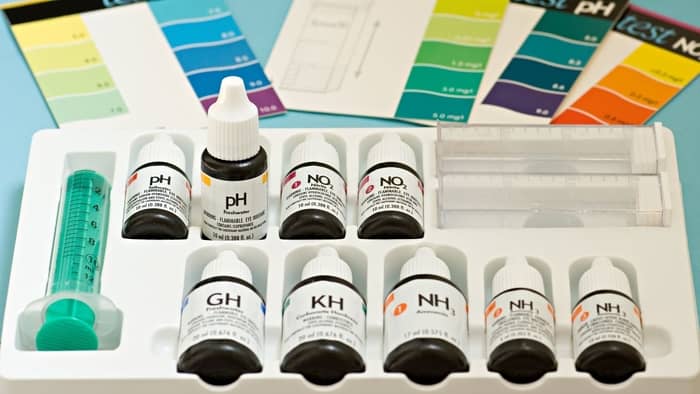Last Updated on March 8, 2022 by admins
Wondering how to raise alkalinity in the aquarium? Keep reading to find out all about this crucial water parameter.
Alkalinity is one of the key parameters for maintaining a healthy aquatic environment. Unfortunately, it is also one of the most overlooked items. Regular water testing will tell you if the water is too acidic or too alkaline for your fish. – This is exactly what every hobbyist should take care of.
Low alkalinity inhibits beneficial bacteria that help process fish waste, so it is necessary to know how to raise alkalinity in the aquarium. Therefore, stay with us and ensure the health of your aquatic pets.
What Is Alkalinity?
In short, total alkalinity is the measurement of all bases in the water. That is the capacity of the water to resist changes in pH that would cause the water to become more acidic. In addition, it can be observed as the strength of a buffer solution composed of weak acids and conjugated bases.
In terms of expression, it can be expressed in parts per million (ppm) or in milligrams per liter (mg / L), where 1 dKH is equal to 17.9 ppm or 17.9 mg / L.
The ideal levels of alkalinity in aquarium tanks are:
- Freshwater Aquarium
This is very different from the type of fish you intend to keep inside. The level of 4-8 KH is taken as an average.
- Fish Only With Live Rock
A suitable level is between 8-12 dKH.
- Reef Aquarium
A reef aquarium is composed of both fish and corals, and a level between 8-12 dKH is recommended.
- Coral only
The recommended level is 6-9 dKH.
Does Low Alkalinity Have A Direct Impact On Water Quality?
That is right, it has a direct impact in several ways. Without an adequate level of alkalinity, water would find it difficult to cope with sudden changes and variations in pH. Since alkalinity itself is the ability to neutralize acids, we conclude that it is extremely important for your aquatic life because it protects or buffers against rapid pH changes.
Is It Necessary To Measure The Level Of Alkalinity In The Aquarium?
Therefore, it is necessary to conduct regular water inspections to ensure a healthy and balanced water system in your aquarium. As for how you can measure the alkalinity of your aquarium water, there are a number of ways and methods to do so. Hobbyists usually decide to buy different test kits.
So, for example, you can buy a test that will give you a range to get an idea if you have a problem. On the other hand, you can get tests that give more extracts of the digital value of your alkalinity.
Take a look at this article as well.
How To Raise Alkalinity In The Aquarium – Freshwater Edition
If you have a freshwater aquarium, consider buying powdered alkaline buffers. You can get them online or at your local pet store. By adding a bit of the buffer to your tank, you can maintain the recommended alkalinity levels and ensure a long and healthy life for your aquarium pets.
You can also use baking soda. It is one of the most common bases added to aquariums for the purpose of raising alkalinity levels. Accordingly, you can add about 1 teaspoon of baking soda per 5 gallons of water. Just, be sure to first dissolve the baking soda in a separate bowl of water, and only then add the solution to the tank and allow it to cycle before reintroducing your fish.
How To Raise Alkalinity In The Aquarium – Saltwater Edition
As mentioned above, you can always use baking soda, but keep in mind to use it in a way that the alkalinity does not get more than 1.4 dKH per day. You can also use soda ash. The most important thing is to follow the instructions given with the product in order to slowly increase the alkalinity. Namely, if you overdo it, it can cause tissue loss or coral bleaching.
If you want to balance and/or increase both the calcium and alkalinity, you can use limewater or Kalkwasser, and even calcium carbonate or carbon dioxide reactors.
In Conclusion
With the right knowledge, as well as a little love and dedication, it can be easy to maintain a healthy alkalinity level. If you find yourself in a situation where its level is too low, it is recommended to take active steps to maintain the alkalinity at the appropriate levels.
Most important of all is to increase the level of alkalinity slowly and wisely. Only in this way will you provide your aquarium pets with everything they need for a long, happy and healthy life.
Do you have experiences or related stories on how to raise alkalinity in the aquarium? Let us know in the comments!
FAQs
How Do I Increase Alkalinity In My Aquarium Naturally?
The best and most natural way to increase alkalinity in your aquarium is to periodically change some of the water from the tank with new water with moderate total alkalinity.
How Do You Treat Low Alkalinity In A Fish Tank?
There are several methods for treating low alkalinity in an aquarium. The two most popular methods are:
Periodic water changes,
Adding chemical buffers such as sodium bicarbonate (baking soda).
How Do I Raise Alkalinity Without Raising Ph In My Aquarium?
If you want to increase the alkalinity in your aquarium tank, it is recommended that you test your pH level first to make sure you are taking the right steps.
When your tank has a higher pH level, try using baking soda as sodium bicarbonate can lower the pH level a bit. On the other hand, if the pH level is comparatively low, using soda ash is recommended. Namely, if you use ash soda in an aquarium tank that comes with a high pH, things can escalate and be fatal for pets.
